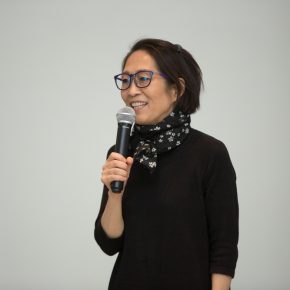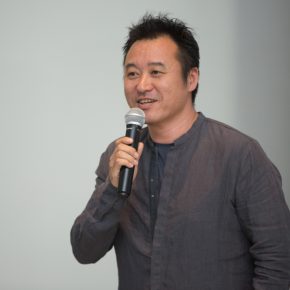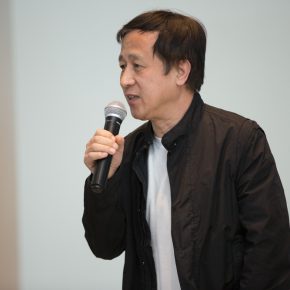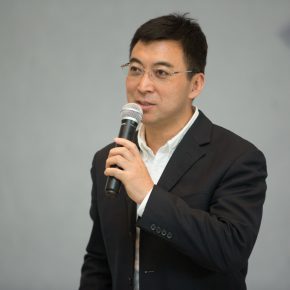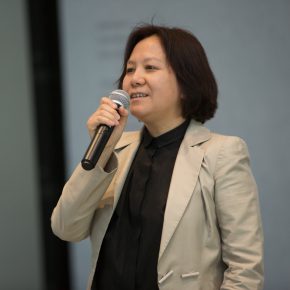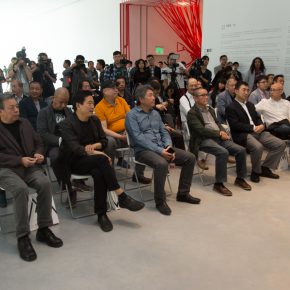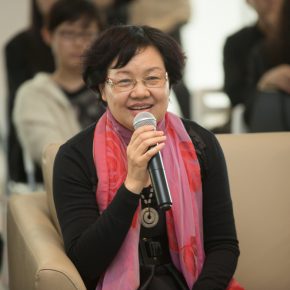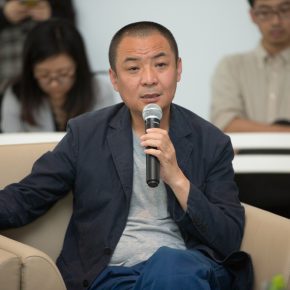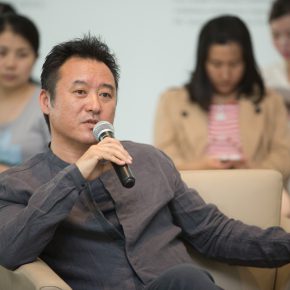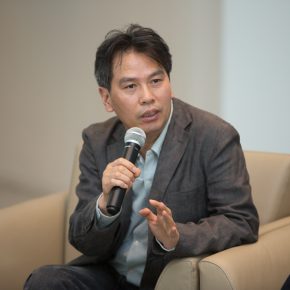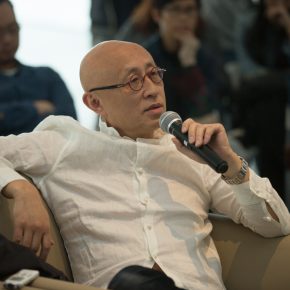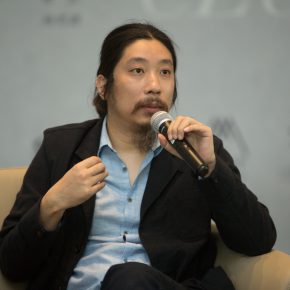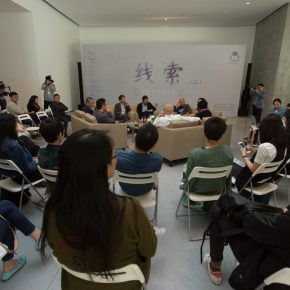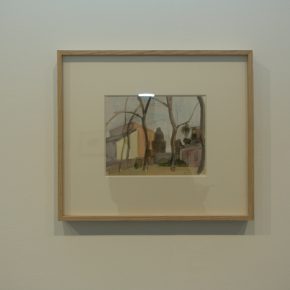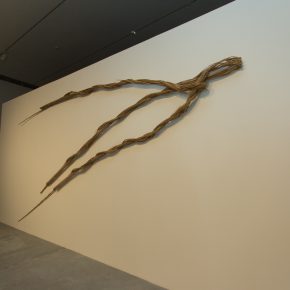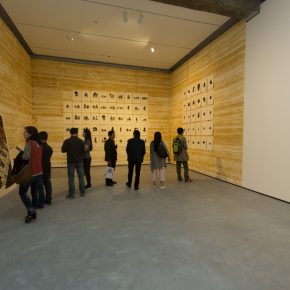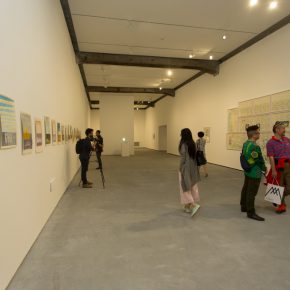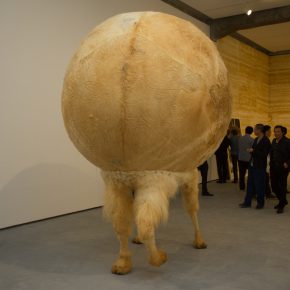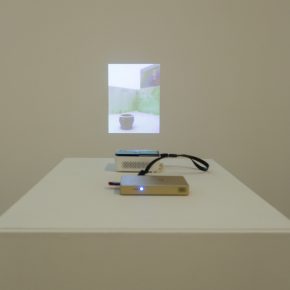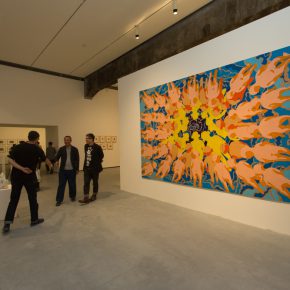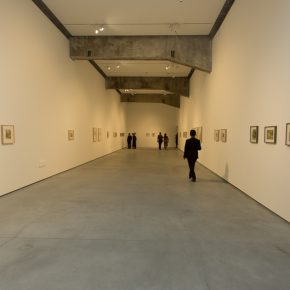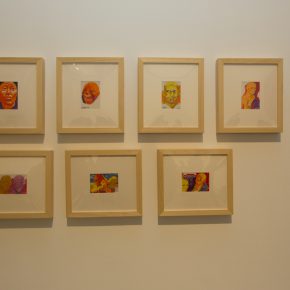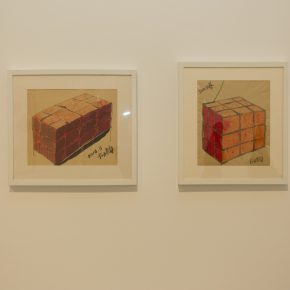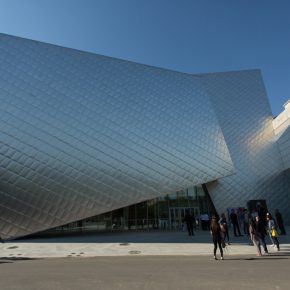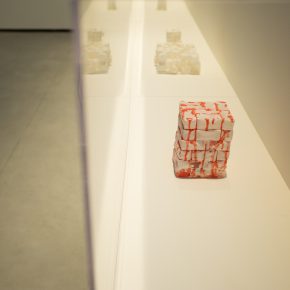
At 3:30 pm on May 12, 2016, curated by Shu Kewen, Clues 3 opened at Beijing Minsheng Art Museum. The Clues 3 presents the creation by Fang Lijun, Wang Yin, Xiao Yu and Yang Maoyuan over the last 5 years, this tries a new investigating pattern of Chinese contemporary art ecology. The exhibition is organized by China Minsheng Bank and Beijing Minsheng Art Museum, co-organized by Beijing Minsheng Foundation for Arts and Culture, Shanghai Minsheng Art Foundation, Shanghai Minsheng Art Museum and Shanghai 21st Century Minsheng Art Museum. Before the opening ceremony of the exhibition, Beijing Minsheng Art Museum also held a discussion about the exhibition. The art critics Wang Duanting, Bao Dong, together with the artists and curator attended the discussion.
The notion of clues originates from a discussion among fellows. It is neither an exhibition with a distinct subject matter nor a synthesis of works, nor a document exhibition in the general sense. As far as the exhibition of each artist's work or idealization of Chinese art ecology is concerned, what is exhibited is a state of "fugacity". The curator Shu Kewen said that, they select a way of chronicling, rather than staging the history of art and analysis of artists’ works the way to elaborate the personal experiences in a story is by relaying as far as possible, to broaden the space of understanding.
Clues series exhibition was initiated in 2005. The project is constituted of a narrative clue which is negotiated together by Fang Lijun, Wang Yin, Xiao Yu,Yang Maoyuan and Shu Kewen, and planned by Shu Kewen. It is held once every 5 years. This year is the 3rd term. The Clues 3 continues with the original idea and method of working. In the last 5 years, the 4 artists have shown new explorations and a new orientation in their artistic creations: Fang Lijun puts more water ink and ceramics into use, while retaining a definite self-consciousness; Wang Yin restarts practicing his previous familiar sketching in the process of teasing modern art from China and new painting after 1949; Xiao Yu selects bamboo as an oriental sign to retrospect traditional aesthetics and to reflect contemporary art; Yang Maoyuan excavates the narrative of cultural roots and the life connotation from the experience of exploring Takla Makan Desert, Lop Nur and Loulan ruins.Shu Kenwen defines her role as a person “who relays stories”, at the opening ceremony, Shu said that the series of exhibition were commonly negotiated by the 5 persons from the Clue 1 held in 2005 to the Clue 3 this year, what she had done was nothing more than relaying the traces revealed in the stories in the working process and the working clue. For this reason Shu has written a column for an art review in Sanlian Lifeweek, she gets acquainted with the people and hears many stories, taking part in their dialogue step by step.
The 4 artists were all born in 1960s, with a similar age and a similar life history. But the 4 artists, as fellows can together accomplish the project, it is not only because of being a similar age, growing up in similar surroundings, educated in the academy, attending much the same course, reading much the same books, drinking almost without difference, it is not only because of their arriving in Beijing in the same period, becoming intimate friends, but also because of the different opportunity when they entering their artistic study and creation. The individual response to the external environment and the different way of reacting to what one cares about makes their working obviously different afterwards. Furthermore, it is the responsibility shaped in everyday communication that makes them mutually observant and more meticulous, more considerate and less accommodating. Hence, an example of an art ecology manifests.
About the exhibition
Artists: Fang Lijun, Wang Yin, Xiao Yu, Yang Maoyuan
Duration: May 12 - Jun 12, 2016
Venue: Beijing Minsheng Art Museum Hall 2
Producer: Zhou Xujun
Curator: Shu Kewen
Assistant Curator: Li Keke
Photo by Yang Yanyuan, text edited by Zhu Li/CAFA ART INFO
Translated by Chen Peihua and edited by Sue/CAFA ART INFO
Preface by Shu Kewen
About Clue?3
Clue is an exhibition composed of work clues of Fang Lijun, Wang Yin, Xiao Yu and Yang Maoyuan, who are close friends. Not confined to a specific theme, the exhibition is neither an anthology of works, nor a documentary exhibition. It traces not only the work clues of an individual artist, but also the almost imperceptible intricate connections among them, who multiply and correlate while working in one's own way, offering potentially a sense of clue with more intensity. The year 2005 witnessed the first exhibition of Clue. Its organization concept was tranquil and calm against the then fevered and bustling backdrop, focusing on retrospect rather than prospect.
The four artists' partnership in the exhibition can’t be solely explained by their similar ages, but are based more on their diversified opportunities in learning art and their artistic creation. Moreover, the responsibility nurtured in their daily contact enables them to observe each other more meticulously, to stand in each other’s shoes more often while not refraining from criticism, thus they present a taste of samples of artistic ecology.
In 2011, after five years which witnessed the prime time of overwhelming art news, while at the same time travelling further on the artistic road or blazing new trails, the idea of a second Clue came to their minds. Besides, 5 years seemed a natural division between an old and a new phase. As a result, we had Clue 2 with the particular marking note of “Individuality” in its title to distinguish itself from the “artistic groups.”
Another five years have passed since Clue 2 before we come to the year 2016, when both the artists and I myself hope to carry on the project. The exhibition was initiated from a tacit “discussion” among friends, or more possibly was a confrontation between each perception drawn from the art practice, as well as aspirations and inclinations of fellow artists. If we start to compare their respective ways of working, we’ll see the obvious distinctions in their work logic and aesthetic taste, as well as the differentiated connections with the realistic context. On that account, what artistic “concept” should be adopted to integrate these works into a mutual connection with a certain sense of structure?
The motivation for such confrontation is primarily derived by the ethics of life connected to traditional daily experiences. In the context of these ethics, what we encounter, think and do will be subject to inquisition and confrontation between each other as something concrete. That is why artistic topics and works can be confirmed as daily experiences in our works and life. Thus spoken, this confrontation is predestined to be a reciprocal cultural necessity, rather than aesthetic wandering, or appreciation and emulation or even grouping among fellow artists. As a result of mutual confrontation, those multiple clues are not clustered and presented in any ultimate form. Though narrated chronologically, the exhibition emphasizes experiences gained from an evolvement in art, rather than the concept of a time sequence. It may take a relatively long time before the“gene” in such a clue is revealed, instead of being articulated in the form of a concept.
Courtesy of the artists and Minsheng Art Museum.


